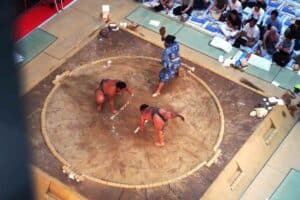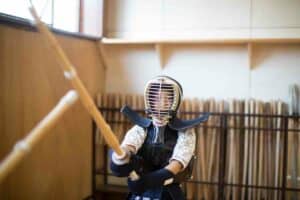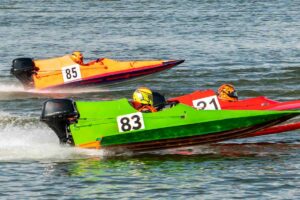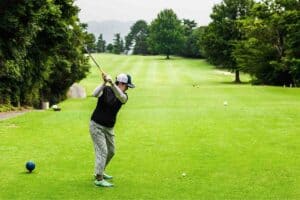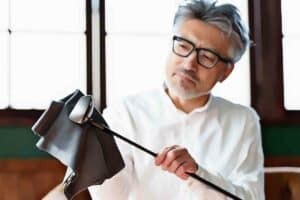Kyudo, which means ‘the way of the bow’ in Japanese, is considered to be the purest of all martial arts.
In years gone by, a bow was used in war, hunting, games, contests, and court ceremonies. Modern kyudo has become a way of moral, spiritual, and physical development.
Read Next ?
The start of the use of the word kyudo isn’t really known.
However, towards the end of the nineteenth century, the term began to be used more widely – especially as bow practice was almost exclusively centered around the individual.
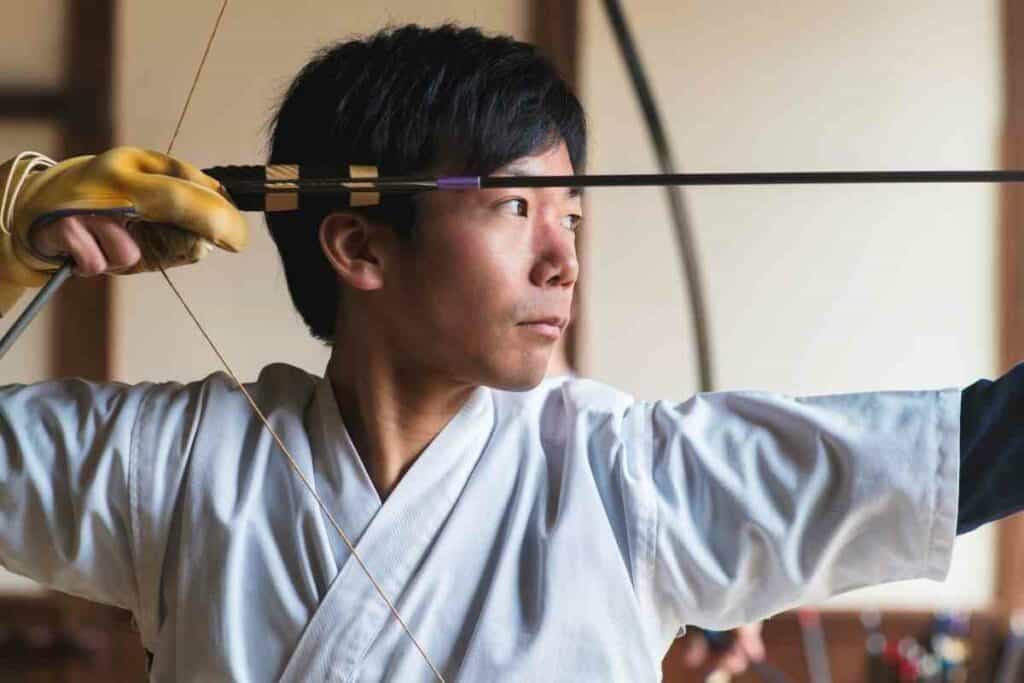
Modern kyudo is, in essence, synonymous with a pursuit of goodness, beauty, and truth.
Table of Contents
Kyudo equipment
Of course, this skill can’t be practiced without equipment.
As well as being a sport, it is a way of self-development.
Training in kyudo comes with training the self and one’s awareness and respect for the kyudo equipment too.
There are three main pieces of kyudo equipment.
These are:
- the Yumi (the bow)
- Ya (arrows)
- and Yugake (glove)
Let’s explore these in more detail.
Kyudo equipment – the Bow – Yumi
There are three basic yumi that are used today.
The first is a standard bamboo bow, then you have a lacquered bamboo bow, and finally a synthetic carbon-fiber or fiberglass bow.
Most practitioners use a standard yumi.
Bamboo yumi
A standard bamboo bow is made in almost exactly the same way as it would have been 500 years ago.
It encompasses clean lines and simplicity and oozes elegance and beauty.
Though not massively delicate, a bamboo bow is susceptible to physical abuse or weather extremes and because of this, you’ll find lots of kyudo schools and clubs that recommend synthetic yumi – particularly to novice practitioners.
Synthetic yumi
In theory, kyudo should be practiced with entirely natural materials.
However, bamboo yumi are quite expensive – you can pay upwards of six hundred dollars for one.
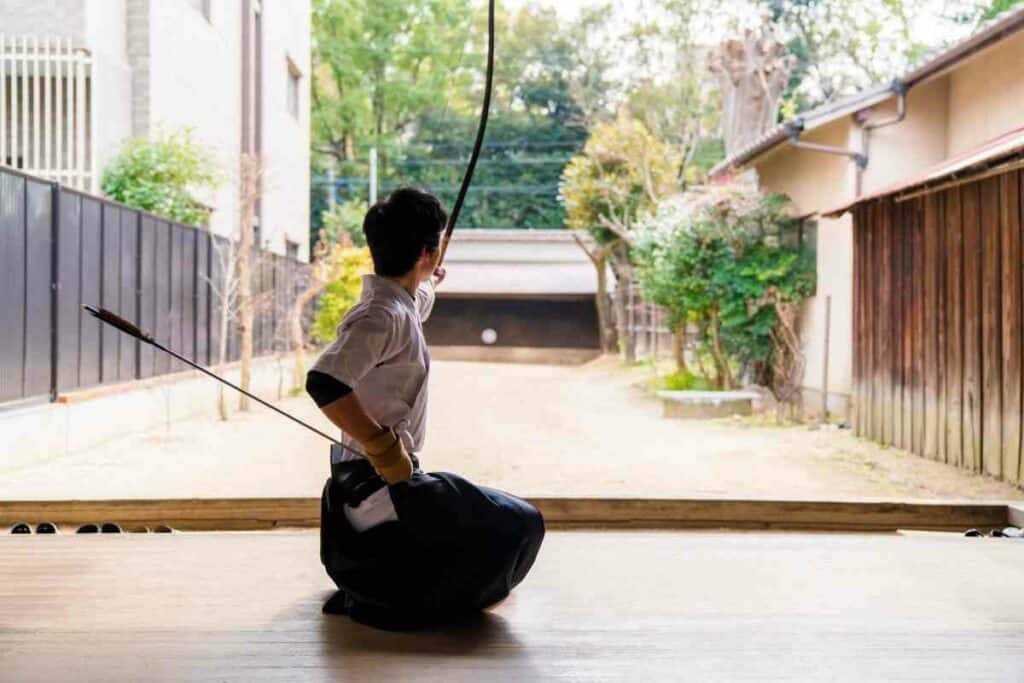
For a beginner, therefore, a fiberglass or carbon fiber bow is recommended until the technique has been perfected and won’t cause excess wear and tear on a bamboo bow.
You can usually pick up a synthetic bow for under $400.
Lacquered yumi
There aren’t many bowmakers making these bows nowadays.
This means that they are very expensive – you’ll often pay $2,000 to $3,000 at least for one of these.
As a Result – These are used for specialist ceremonies usually and even then, only the most advanced practitioners will use them.
Bow pull strengths and lengths
You can get a range of pull strengths and lengths of bows.
Most people begin with a bow that has a 10-12 kilogram pull strength.
After around a year or slightly over a year, people will then start using bows with high pull strengths.
In terms of averages, your experienced female kyudo practitioner will use a 14-16 kg yumi, while an experienced male practitioner will use an 18-20 yumi.
Of course, all of this will depend on the person’s body type and their kyudo experience.
Kyudo equipment – arrows – ya
Kyudo arrives are made of a special type of bamboo called yadake.
This bamboo is hardened and then hand aligned. In fact, the manufacture of these bamboo ya is also an art form in its own right.
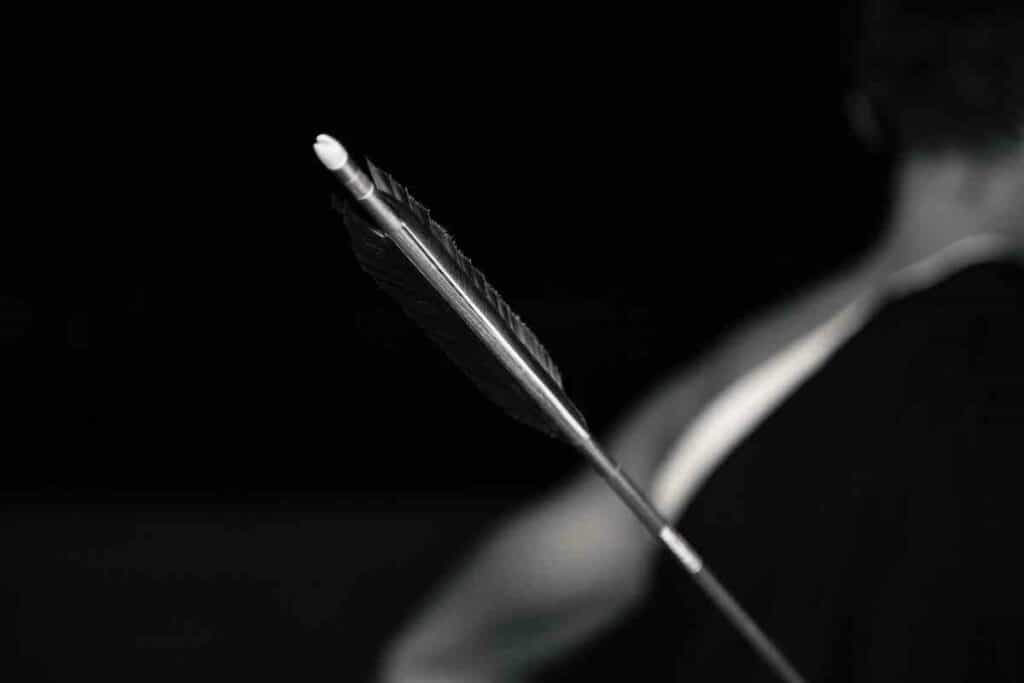
Traditionally, eagle or hawk feathers (specifically the wing feathers) were used in the fletching but now these are designated as protected species, you can only get these feathers from existing supplies.
Consequently, it’s rare to find new fletching with eagle or hawk feathers.
More common nowadays are synthetic flights. Kyudo arrows have also started to be made with harvested turkey and swan feathers.
How the ya differ from other arrows
Because Japanese yumi are drawn to a longer length than Western bow and arrow combinations, the arrows are longer than their western counterparts.
Traditionally, the arrow shafts were made of yadake, a special bamboo variety.
However, lots of kyudo clubs and schools are now using aluminum shafts, especially when they have a lot of beginner kyudo practitioners.
Given that the feathers used in the fletching come from either the left wing or the right wing of the bird, they will have a natural curve to the right or left.
When feathers curve to the left, they are referred to as haya. They’re also called ‘first arrows’.
When feathers curve to the right, they are referred to as otoya. They’re also called ‘second arrows’.
You would traditionally use these arrows in a pair. The haya will rotate clockwise when it’s airborne, while the otoya will rotate counterclockwise.
Types of arrows in Kyudo
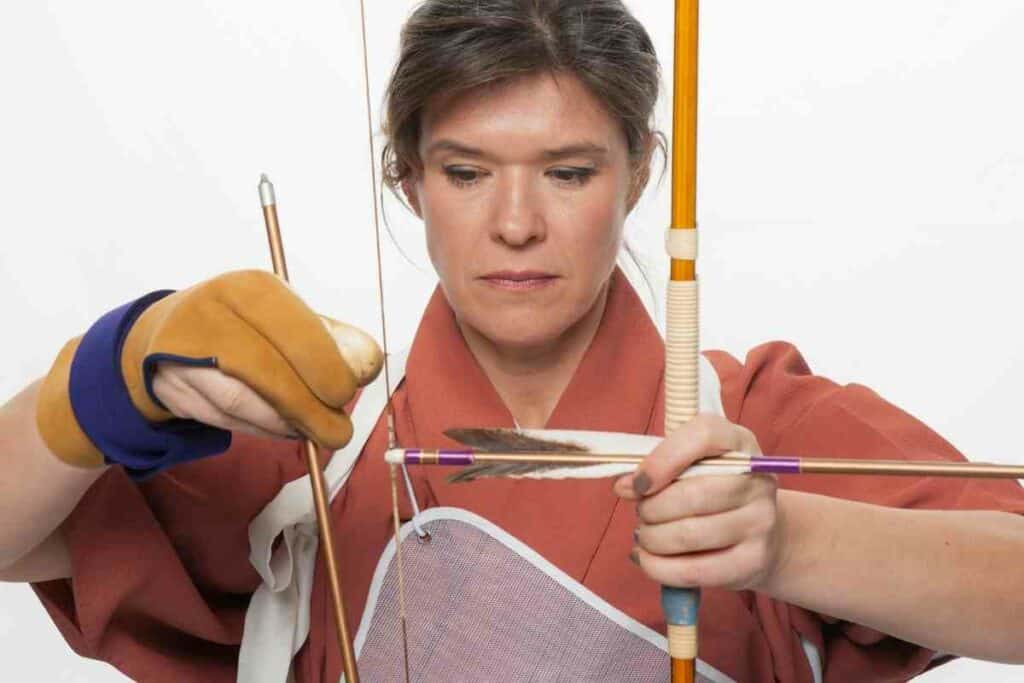
Kyudo has a variety of arrow types.
These are:
- Boya – a close-range practice arrow with no feathers
- Makiwaraya – a close-range practice arrow with feathers
- Kazuya – a practice arrow for distance targets
- Yotsuya – a set of 4 target distance arrows
Arrow length
A person’s arrow length is decided by their yazuka – or their draw length – with a few extra centimeters added on for safety.
With experience, a yazuka will change but the general rule is to extend your arm fully and measure from the center of your throat to the end of your fingers.
To This Length – Add five centimeters as a safety margin if you’re experienced and a few more than that if you’re a beginner.
Arrow maintenance
Bamboo arrows can be damaged easily by very dry conditions.
You can protect them a little by rubbing a light oil into them periodically, provided that the oil is light. The best oils are camellia and walnut oils.
For the feathers, these can be steamed into shape, but you should take care not to loosen any of the binding agents holding them in place.
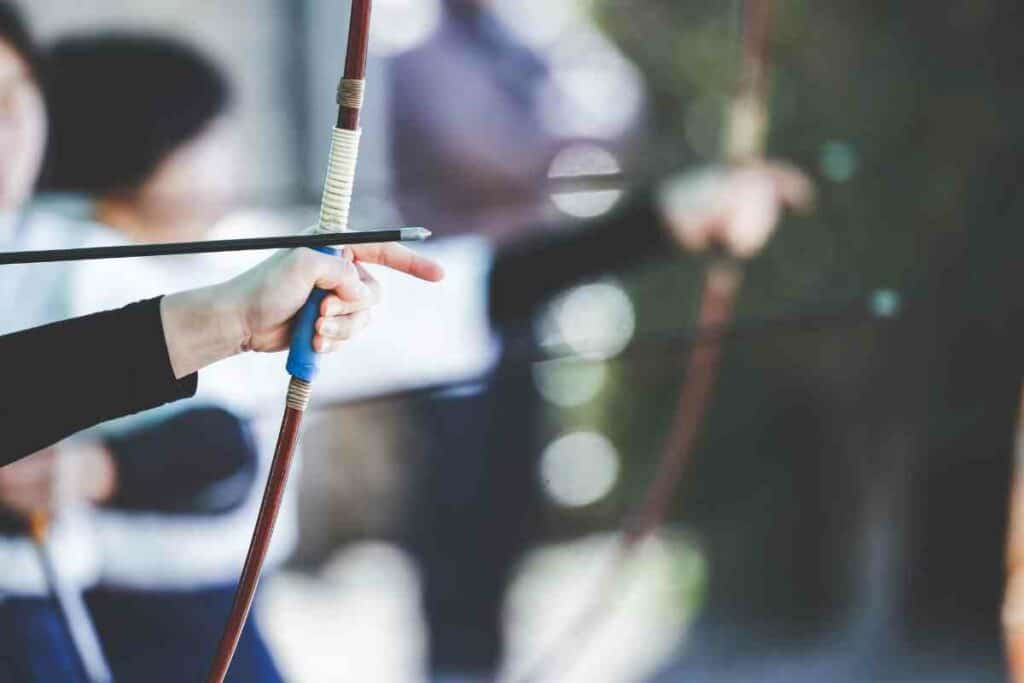
If the arrows aren’t used very often and conditions are damp, the metal points can go rusty. This rust can be taken off with a fine sandpaper.
Should bows be damaged, a specialist arrow make might be able to fix them.
However, for standard arrows that most beginners use, the cost of repair will often outweigh the cost of a new arrow.
Kyudo equipment – glove – yugake
Yugake are made from specially farmed deerskin.
These gloves come in a few different types:
- Three finger – a mitsugake
- Four finger – a yotsugake
- Five finger – a morogake
Each type of glove is matched to a practice level and tradition.
The three-finger mitsugake is commonly used by bushakei-style archers while the four-finger yotsugake is preferred by reishakei archers.
Finally, the morogake is mainly used by Ogasawara Ryu arches and is specially made.
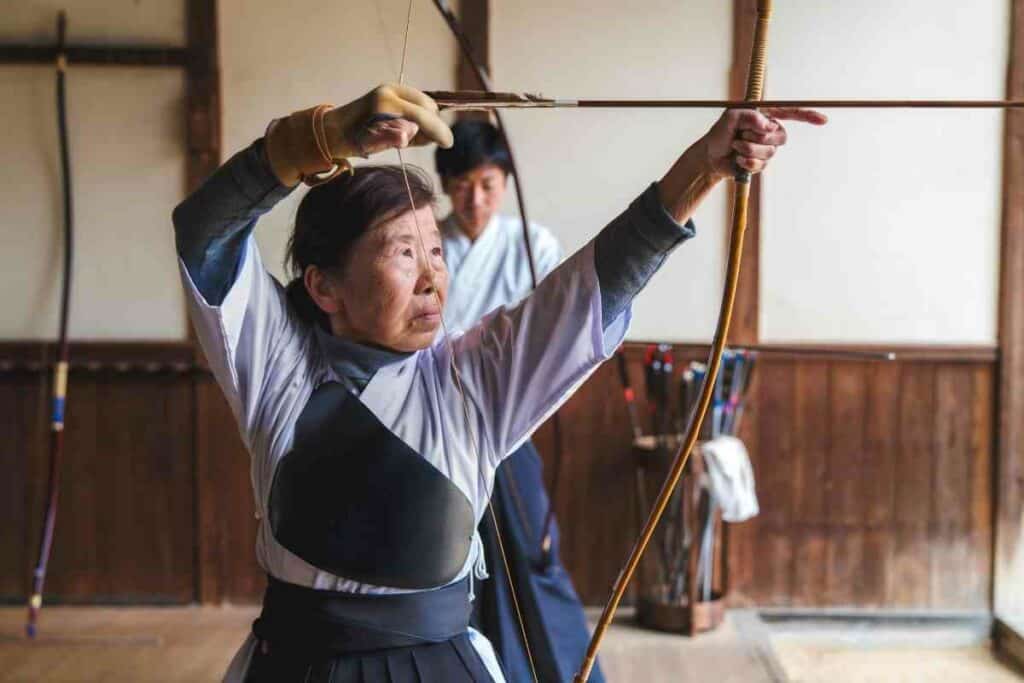
Novice archers will use a mitsugake because it is easier to use and costs less – this is regardless of the style of kyudo practiced.
The most common type of glove will have a rigid wrist and hardened thumb.
Kyudo gloves are pretty different from Western archery gloves. They have wrist support and a hardened thumb.
Kyudo equipment – Yugake maintenance
Protecting the yugake from body oils and moisture is important.
Archers should wear a shitagake underneath it whenever it’s worn. The shitagake is an under glove made of cotton. This protects the yugake’s leather and keeps it in the best condition.
After use, both the yugake and shitagake need to be left to dry before being stored away. This is to allow any perspiration to dry.
The cotton shitagake can be washed regularly. If it becomes heavily stained or soiled, it can be discarded and replaced.
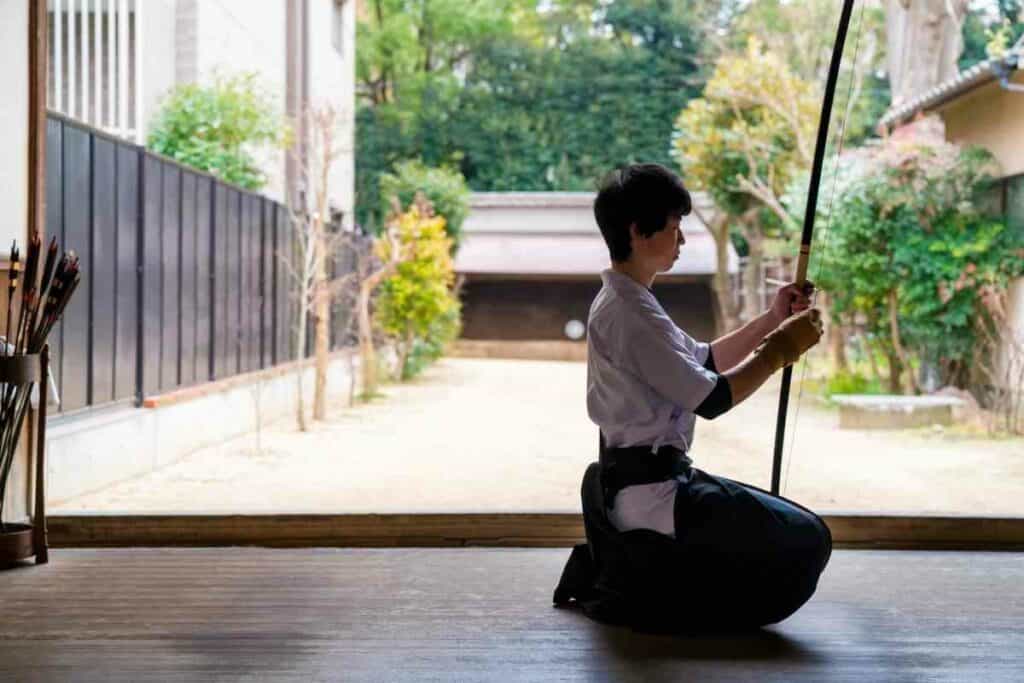
The yugake needs to be kept in a silk or cloth bag to protect it.
Should it get soiled, a soft gum eraser or damp cloth can be used. You should never use a solvent cleaner, though, as this will damage the leather.
If the yugake has any torn seams, a professional should be hired for the repairs. A yugake will be considered irreparable if the hardened thumb or wrist areas are damaged.
Final thoughts on kyudo equipment
Just like kyudo is about respect, practitioners must respect the equipment used in the art.
Kyudo practitioners should always use the appropriate size and pull strength bow, the correct length of arrows, and the appropriate size and type of glove.
With the right equipment in use and the appropriate maintenance of the equipment, the kyudo experience will be unbeatable.

